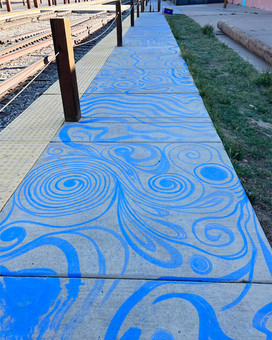
Before the bone-dry hardscape, there was a swirling body of water that preceded us. Its presence may have been lost to development and climate change, but we can still conjure its ghost through brushstrokes on the land.
Missing Waters, Santa Fe
Railyard Park (site of the historic Acequia Tenorio), Santa Fe, New Mexico, 2025
Presented by ecoartspace and the Railyard Park Conservancy and working with New Mexico High School for the Arts students, organized by teacher, Karina Hean
Materials
A paintable slurry of non-polluting blue chalk and water
Dimensions
¾ of a mile running through the Railyard Park
It was not always so dry in this town. Over forty acequias once flowed through the land which is now Santa Fe. Now there are only four in the city. It is important to conjure these missing waterways to get in touch with Santa Fe’s more watery past. Stacy Levy has been working to tell the story of ghost waterways—at full scale and on the very sites where the waters had actually flowed. She has orchestrated these Missing Waters maps, temporarily painted on the ground surface in New York, Brooklyn Philadelphia and Akron and Charlotte NC. This event is her first Missing Waters painting west of the Mississippi.

The water map painting is created with many people, over the course of three days, and are temporary—lasting only until the next rain storm or wearing away in a few days. Stacy worked with groups of New Mexico School of the Arts students, and neighbors, volunteers and people passing by: inviting them to paint a memory of old water flowing across a present-day hardscape.

Participants were encouraged to feel the connection between the fluid movement of their brushstrokes and the watery past of Santa Fe.
Using a non-polluting blue chalk and water slurry mixed on site, everyone is given a small bucket of paint and a brush, and a lively discussion of hydrology and history and rules for painting together. This is an organized collaborative project: participants get to make the patterns of flow with their own marks within the overall design of the waterway. Some people paint for 15 minutes, some paint for several hours, as the group moves down the borders of the old waterway. Participants find it joyous to draw with sweeping gestures of drawing with their whole arm; and it is satisfying to make a highly visual project with so many people working together.
The watery map stretches next to a railroad, again showcasing the contrast between today’s urban hardscape and Santa Fe’s watery past… The Spanish word acequia ( irrigation ditch) originates from the Arabic name al-saquia which means "Water Carrier". The technical system of the acequia, a way of irrigating agricultural lands in a dry climate was developed in the Middle East and brought to Spain by the Moors. It was later introduced to the American Southwest by Spanish colonists, as a way to use gravity's flow to control the irrigation of Santa Fe and other Spanish mission towns.
As if the message of droughty times was read from the sky, the long awaited rains poured down on the last day of painting. Santa Fe had been experiencing a severe drought with below average precipitation for the spring months.

This overhead shot of this collective painting action allows us to see where the water might have been despite today's urban obstacles of train tracks, buildings, and hardscapes. It also highlights the contrast between Santa Fe’s current desert environment marked by extreme droughts and the historic Acequia Tenorio.
The act of painting allowed space for discussion among participants about the patterns of hydrology, the beautiful curving forms of vortices that water makes as it moves.
Over the course of three days filled with painting and discussion, the memory of these missing waters was conjured – reminding us of historic significance of the acequias and how these historic water sharing systems are the oldest depiction of Indigenous and European resource management still active in the United States today.

Beyond this collective painting action in Santa Fe, temporary painted maps have been created in New York, Brooklyn, Philadelphia, Akron, and Charlotte, NC. This marks her first Missing Waters project west of the Mississippi…
To learn more about other Missing Waters projects watch this video
The patterns are all individual, but they hang together like a quilt stitched of blue marks.
Seen from above and walking over the path, the grey hardscape turns in to a flowing waterway.
Select photography © Shayla Blatchford









































